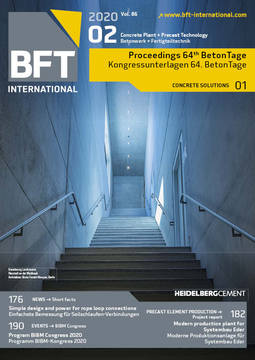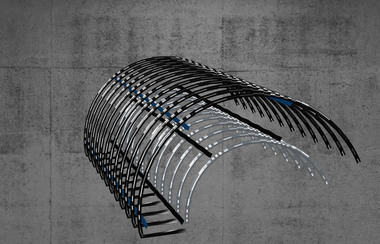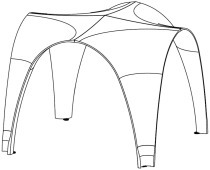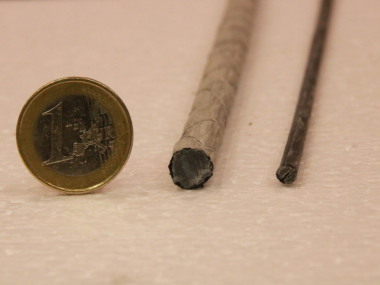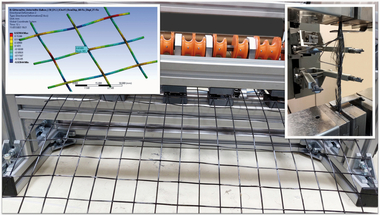Novel carbon-fiber reinforcement for concrete 3D printing and other methods
Mineral-impregnated carbon-fiber composites (MCFs) constitute a new type of reinforcement for construction. While inheriting the advantages of existing carbon-fiber reinforcements, which are composite materials made of carbon filaments embedded in a thermoplastic or thermosetting matrix, MCFs surpass the limitations of such polymer-impregnated types. More specifically, mineral impregnation considerably improves the performance of the reinforcement at elevated temperatures, enhances its bond to the concrete matrix, and increases technological flexibility, especially with respect to emerging automated production methods [1, 2]. This article briefly presents the technology for the continuous impregnation of carbon yarns with appropriately chosen fine mineral binder suspensions and several examples of the automated manufacturing of reinforcement systems made of this new composite material, including concrete 3D printing. An extended presentation of the work can be found in the publications cited below.
Materials and impregnation procedure
One of the most important prerequisites for the continuous production of mineral-impregnated carbon-fiber composites is the selection of appropriate materials. Several engineering challenges need to be mastered as a result of the specific geometrical features (bundles of many thousands of very fine filaments) and chemical nature of CF. The slurry for impregnation must consist of binder particles with well-defined sizes in the range of or lower than the diameters of the individual CF filaments. Another indispensable requirement for adequate penetration of the suspension into the interior of a yarn is the application of mechanical force. The required pressure can be achieved, for instance, through multiple deflection by means of a padder with a number of rolls [2, 3]. This process step has been successfully applied for both cementitious and geopolymer suspensions. MCFs produced in this way exhibited a tensile strength of approximately 2,250 MPa and a modulus of elasticity of 225 GPa at an age of 28 d. This is well within the range of typical reinforcements made of fiber-reinforced polymers (FRPs). Note that the given values are calculated using the sum cross-sectional area of all carbon filaments as a reference for the composites made both of MCF and FRP. Several types of post-treatment can be applied after impregnation, depending on the material composition and envisaged application. Details can be found in [3].
Automated production of one-, two- and three-dimensional reinforcement elements
Various scenarios for the automated manufacturing of reinforcement systems made of this new composite material have been developed at the Institute of Construction Materials of TU Dresden [3, 4]. For the continuous production of rebar consisting of several individual heavy tows, a pultrusion process was found to be particularly suitable. At this stage, the pilot installation enables a process velocity of 12 m/min, but there is still considerable potential for increasing the production rate. For the production of two- or three-dimensional reinforcement meshes, a continuous robotics-based structuring process was developed. The CF yarn is first impregnated with a mineral suspension and then deposited into the desired structure by a robot. Such individual structuring can be achieved either by a stress-free deposition of the mineral-impregnated yarn or by deflection around defined fixed points; see Fig. 1. Both procedures enable the fully automatic manufacturing of tailor-made products, which leads to labor savings and an enormously shortened production chain. Additionally, since material offcuts or connecting overlaps are avoided, this approach gives rise to extremely high material efficiency. Several applications have been demonstrated, including the production of two-dimensional mesh, a shell reinforcement structure (Fig. 1), a 3D-reinforcement structure for a balcony, etc. [3, 4].
Integrating carbon-fiber reinforcement into concrete 3D printing
Digital concrete construction is increasingly moving into the focus of research and industry, see e.g. [5, 6]. In the current state of the art, additive manufacturing with concrete takes place either completely without reinforcement or the reinforcement is inserted manually and intermittently, which contradicts the principle of additive manufacturing [7]. The direct integration of the mineral-impregnated carbon-fiber reinforcement into the printing process presents a solution to this problem [4]. The horizontal reinforcement layers can be easily laid together with the respective concrete filaments, see Fig. 2. There are basically two options: On the one hand, the reinforcement can already be integrated into the concrete filament in the concrete pressure nozzle. Furthermore, it is possible to deposit the reinforcement on a previously printed concrete filament and to cover it directly with another. The advantage of the second method is that the reinforcement can be inserted independently of the concrete deposition and thus the overlapping of different reinforcing strands is possible. The patent filed by the Institute of Construction Materials at TU Dresden also provides variants for the production of vertical and inclined reinforcement layers. A comprehensive scientific publication on the integration of carbon reinforcement into concrete 3D printing will be available soon.

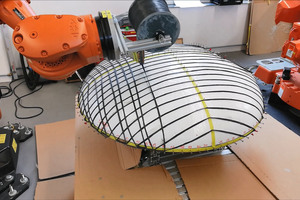
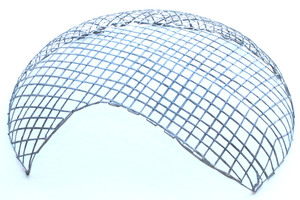
![Fig. 2: Mineral-impregnated carbon-fiber composite (MCF) in the concrete 3D printing process; left: coupled deposition of concrete and MCF; right: cut of a printed wall element [4]](https://www.bft-international.com/imgs/1/5/3/0/5/6/6/tok_66f99ef58d5121e8f55d1b80979ec95c/w300_h200_x499_y245_8_4_Mechtcherine_Fig._2-b7f097a623a80165.jpeg)





